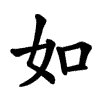Definify.com
Definition 2025
几
几
| ||||||
|---|---|---|---|---|---|---|
Translingual
| Stroke order | |||
|---|---|---|---|

| |||
Han character
几 (radical 16 几+0, 2 strokes, cangjie input 竹弓 (HN), four-corner 77210)
- Kangxi radical #16, ⼏ (“table”).
Derived characters
- Index:Chinese radical/几
- 殳, 肌, 飢, 机, 且, 䢳, 㞦, 孕
- See also Index:Chinese radical/風
- See also 凡#Derived characters
References
- KangXi: page 133, character 57
- Dai Kanwa Jiten: character 1737
- Dae Jaweon: page 299, character 8
- Hanyu Da Zidian: volume 1, page 275, character 19
- Unihan data for U+51E0
Chinese
Glyph origin
| Historical forms of the character 几
| ||
|---|---|---|
| Bamboo and silk script | Large seal script | Small seal script |
 |
 |
 |
| Characters in the same phonetic series (几) (Zhengzhang, 2003) | |
|---|---|
| Old Chinese | |
| 肌 | *kril |
| 飢 | *kril |
| 机 | *kril, *krilʔ |
| 虮 | *kril |
| 几 | *krilʔ |
| 麂 | *krilʔ |
Pictogram (象形) – stool (viewed from the side).
Etymology 1
|
simp. and trad. |
几 | |
|---|---|---|
| alt. forms | 𠀃 | |
Pronunciation
- Mandarin
- Cantonese (Jyutping): gei1, gei2
- Min Dong (BUC): gī
- Min Nan (POJ): kí
- Wu (Wiktionary): ji (T2)
- Mandarin
- (Standard Chinese, Beijing)+
- Pinyin:
- Zhuyin: ㄐㄧ
- Wade-Giles: chih1
- Gwoyeu Romatzyh: ji
- IPA (key): /t͡ɕi⁵⁵/
-

- (Standard Chinese, literary variant in Taiwan)+
- Pinyin:
- Zhuyin: ㄐㄧˇ
- Wade-Giles: chih3
- Gwoyeu Romatzyh: jii
- IPA (key): /t͡ɕi²¹⁴/
- (Standard Chinese, Beijing)+
- Cantonese
- (Standard Cantonese, Guangzhou)+
- Jyutping: gei1, gei2
- Yale: gēi, géi
- Cantonese Pinyin: gei1, gei2
- IPA (key): /kei̯⁵⁵/, /kei̯³⁵/
- (Standard Cantonese, Guangzhou)+
- Min Dong
- (Fuzhou)
- Bàng-uâ-cê: gī
- IPA (key): /ki³³/
- (Fuzhou)
- Min Nan
- (Hokkien)
- Pe̍h-ōe-jī: kí
- Tâi-lô: kí
- Phofsit Daibuun: kie
- IPA (Xiamen): /ki⁵³/
- IPA (Quanzhou): /ki⁵⁵⁴/
- IPA (Zhangzhou): /ki⁵³/
- IPA (Taipei): /ki⁵³/
- IPA (Kaohsiung): /ki⁴¹/
- (Hokkien)
- Wu
- (Shanghainese)
- Wiktionary: ji (T2)
- IPA (key): /t͡ɕi³⁴/
- (Shanghainese)
| Rime | |
|---|---|
| Character | 几 |
| Reading # | 1/1 |
| Initial (聲) | 見 (28) |
| Final (韻) | 脂 (15) |
| Tone (調) | Rising (X) |
| Openness (開合) | Open |
| Division (等) | III |
| Fanqie | 居履切 |
| Reconstructions | |
| Zhengzhang Shangfang |
/kiɪX/ |
| Pan Wuyun |
/kiX/ |
| Shao Rongfen |
/kjɪX/ |
| Edwin Pulleyblank |
/kiX/ |
| Li Rong |
/kiX/ |
| Wang Li |
/kiX/ |
| Bernard Karlgren |
/kiX/ |
| Expected Mandarin Reflex |
jǐ |
| Baxter-Sagart system 1.1 (2014) | |
|---|---|
| Character | 几 |
| Reading # | 1/1 |
| Modern Beijing (Pinyin) |
jǐ |
| Middle Chinese |
‹ kijX › |
| Old Chinese |
/*C.kr[ə]jʔ/ |
| English | stool |
Notes for Old Chinese notations in the Baxter-Sagart system: * Parentheses "()" indicate uncertain presence; | |
| Zhengzhang system (2003) | |
|---|---|
| Character | 几 |
| Reading # | 1/1 |
| No. | 5760 |
| Phonetic component |
几 |
| Rime group |
脂 |
| Rime subdivision |
1 |
| Corresponding MC rime |
几 |
| Old Chinese |
/*krilʔ/ |
Definitions
几
Descendants
Others:
- Vietnamese: ghế (“chair”)
Compounds
|
|
|
Etymology 2
| For pronunciation and definitions of 几 – see 幾 (“how many; some; fine”). (This character, 几, is the simplified form of 幾.) |
Notes:
|
Etymology 3
| For pronunciation and definitions of 几 – see 人. (This character, 几, is a variant form of 人.) |
Etymology 4
| For pronunciation and definitions of 几 – see 明. (This character, 几, is an ancient form of 明.) |
Etymology 5
| For pronunciation and definitions of 几 – see 𠘧. (This character, 几, is a variant form of 𠘧.) |
Japanese
Kanji
几
- table, table enclosure
- table or wind radical
Readings
Compounds
Korean
Hanja
几 • (gwe) (hangeul 궤, revised gwe, McCune-Reischauer kwe)
- This term needs a translation to English. Please help out and add a translation, then remove the text
{{rfdef}}.
Vietnamese
Han character
几 (kỉ)
- This term needs a translation to English. Please help out and add a translation, then remove the text
{{rfdef}}.